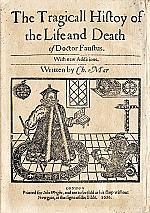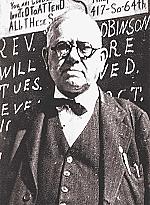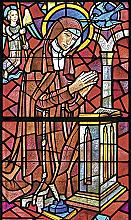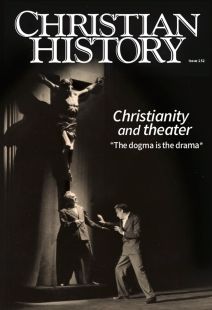Reforming drama
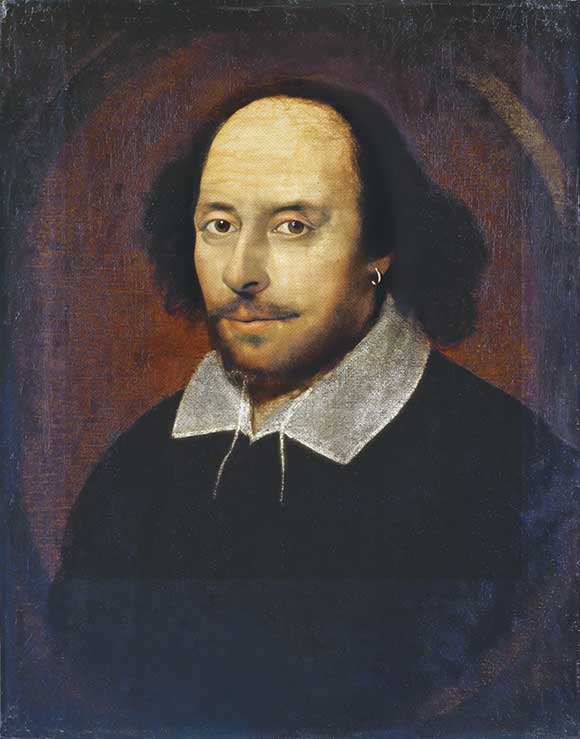
[Above: Attr. John Taylor, “Chandos” Portrait of William Shakespeare, oil on canvas, 1610.—National Portrait Gallery, London / Public domain, Wikimedia]
Popular perceptions of the reason for the English Reformation might be summed up by Anne Boleyn’s words in the song “Don’t Lose ur Head” by Toby Marlow and Lucy Moss in their musical, Six (2017):
Tried to elope
But the Pope said, “Nope!”
Our only hope was Henry—
He got a promotion
Caused a commotion
Set in motion the C of E [Church of England]
Henry VIII’s (1491–1547) desire for a divorce was, of course, only one reason for the English Reformation. However, one product of the messy and ongoing break with the Catholic Church might come as a surprise. In an effort to separate himself from Catholic influence, Henry sought to suppress iconographic practices, including religious theater. As England’s religious allegiances shifted from monarch to monarch and between Protestantism and Catholicism, English theater reflected the tumult.
POLEMICAL PLAYWRIGHTS
Though they held opposite religious convictions, two men bridged the theaters of the medieval and early modern worlds through their unique lenses on the Reformation. Anti-Catholic preacher and playwright John Bale (1495–1563) worked for Thomas Cromwell (1485–1540), while John Heywood (c. 1570–1641), a devout Catholic playwright, actor, and author, worked for Henry (and later Edward, Mary, and Elizabeth).
Heywood’s best-known work is The Play of the Wether (1533). It was a “moral interlude” that served primarily as entertainment rather than as a morality play. Nevertheless like its medieval predecessors, it featured stock characters, an allegorical “Vice” (Merry Report) and a deliberately classical god (Jupiter) rather than the pope or the Christian God. Jupiter dialogues with different characters who each beg him to make conditions more favorable for them.
The conflict Jupiter faces clearly parallels contemporary Catholic and Protestant competitors for Henry’s religious favor. As the play closes, Jupiter reasserts his power and godly “right” to “serve as many or as few as we think best” since “the direction of that doubtless shall stand / perpetually in the power of our hand.” Heywood, in his “moral,” urged Henry to assert his authority and not be swayed by any of these voices and the demands they were making. Heywood toed the line (sometimes) but never hid his Catholic faith, and, although he wrote plays flattering his monarch (and employer), he also wasn’t afraid of writing “morals” that might protect his own interests.
Bale wrote more directly polemical plays. Through his central figure, Baleus Prolocutor, he showed how Catholicism had no place in England and asserted the merits of English Protestantism. In plays like King Johan (c. 1536–1538), about a historical figure (King John) who also had conflicts with Rome, Bale employed allegorical figures.
They had more of a patriotic than papal flavor: Sedition (who works for Antichrist), Clergy, Nobility, Civil Order, Usurped Power, and Private Wealth join the stage with the poor widow who personifies England. The villains are Nobility, who “took an oath to defend the church evermore” and sides with Sedition, and the Clergy, who likewise follows the pope, while Civil Order and King John are on the side of “good” as they set out to remove the influence of Rome.
This use of historical figures to comment on conflicts in contemporary society at a safe historical distance fed into the historical plays that form much of William Shakespeare’s (1564–1616) early theatrical output. The same religious conflict surfaced again and again across the plays of many early modern dramatists, Shakespeare included, as ideas about order and disorder, legitimacy and illegitimacy, and the divine right of kings took on heightened associations, especially when a king with a Catholic background (James I of England and VI of Scotland) had to be imported to England from Scotland (1603). Unsurprisingly, disruptions to order and ideas about fate, prophecy, and predestination, as well as guilt and the fall of man, surface again in Macbeth—a play first performed in 1606 in the wake of James’s ascension to the throne.
FIERY INTERLUDES
In some early modern plays, medieval traditions bleed directly into early modern practices. For instance The Spanish Tragedy (1592) by Thomas Kyd (1558–1594) features a personified revenge alongside the Ghost of Andrea, whose death and subsequent whodunnit narrative is dramatized in the play. Although a retrospective story, it raises questions about the determinism or predestination of events, particularly when Revenge asserts that he has the power to change “peace to war” and “friendship into fell despite.” Later Revenge claims to be the “hand” that “shall hale them down to deepest hell / where none but furies, bugs and tortures dwell.” More blatantly, the ghost demands that he “be judge” and calls for one character to be “dragged through boiling Acheron / And there live, dying still in endless flames.” The play concludes with a moralistic vision of their “endless tragedy.”
As the title indicates, Kyd’s play was set in a Catholic location, and the characters’ hellish violence and inhumane behavior suggest an indictment of Catholicism. Kyd played with other Catholic spaces too: a ghost in a liminal space suggestive of purgatory and ideas of weighed judgment and of souls balanced with retributive or potentially purging revenge. The links with later plays are obvious, like Shakespeare’s Hamlet, first performed around 1600, but so too are links with the soul journeys of earlier medieval plays like Everyman (c. 1510).
Even more directly Christopher Marlowe’s (1564–1593) potentially blasphemous Doctor Faustus (1604) featured an overreaching academic who sells his soul to the devil in exchange for 18 years of unholy fun, earning him the title of (perhaps) a ghost “newly crept out of / Purgatory.” Marlowe also included the devil, Faustus’s own personal devil (Mephistopheles), good and evil angels, the seven deadly sins, and visions of heaven (lost) and hell with “Furies tossing damned souls / On burning forks.” At the end Faustus cries for mercy and has visions of “Christ’s blood [which] streams in the firmament” as he urges us to “see, see.” The play’s final speech is full of tortuous debates about whether he “must be damned” or whether he might indeed “leap to my God!”
SPIRITUAL SHAKESPEARE
Shakespeare, a contemporary of Marlowe and Kyd, wrote in the wake of, and sometimes competing with, such plays. He lived in a world where religion permeated everything. In early modern England, sermons entertained as much as the theater did. Shakespeare had an interest in religion and its dramatic potential and entertainment value. Keen to avoid the censors and to retain his legally necessary patronage, Shakespeare masked political commentary behind foreign (Catholic or otherwise contraband) locations and the shadow of the past.
Although as scholar John Cox noted, Measure for Measure, first performed 1604, was “the only play Shakespeare wrote with a biblical title” (see Matt. 7:2), this was not his only play drawing on religious inspiration. Shakespeare often wove biblical stories, characters, and moments into his plays. Spiritually loaded terms pop up like jack-in-the-boxes. Alongside both Protestant and Catholic Christianity jostle, as Cox notes, “Judaism, Islam, and the state religion of ancient Rome,” as well as occult beliefs, such as curses, witches, and magic. These paired with other kinds of “othering” of the characters, especially racially in the cases of Aaron (Titus Andronicus) and Othello (Othello).
Moreover as the title of Measure for Measure indicates, Shakespeare was interested in matters of justice, mercy, legalistic interpretations of Scripture, and the fractures of a society where religion and its spouters were inherently hypocritical and used their version of Christianity as a disguise to control the lives of others (the Duke of Vienna disguises himself as a friar for most of the play). In the same play, chastity and the sanctity of a nun’s virginity are challenged, and ideas about “purity,” “truth,” and even what it means to be a Christian are scrutinized. Clearly Shakespeare sought to critique more than just Catholicism.
Hamlet also explores religious matters, with its consideration of the sanctity of dialoguing with God in prayer and its explorations of life, death, and the afterlife: in the titular character’s contemplation of suicide, of what may come “when we have shuffled off this mortal coil,” and of what fate might await him if he acts to avenge his father’s ghost. But perhaps the most direct treatment of religion by Shakespeare continues to be Merchant of Venice, first played in 1598, with its problematic depiction of “Christian” mercy in Portia’s speech and Shylock’s own interrogation of “Christian” mercy in his soliloquy “Hath not a Jew eyes?” Shakespeare was interested in the power dynamics at play in a Christian society and what it means to “put on” religion, particularly when the shape of Christianity kept shifting in his own day.
EMBODIED RESURRECTION
Shakespeare didn’t write Christian drama. Except when he did. His aim was not to set out to script biblical narratives on stage nor even to have a clear “moral.” However, his plays certainly contain Christian moments, and those that might point toward the dramatic Christian story. These moments do not need to occur in a Christian world. For instance in King Lear, Gloucester, scarred with his recent blinding, highlights the vulnerability and littleness of humans, in relation to the gods: “As flies to wanton boys, are we to the gods. / They kill us for their sport” (4.1). This recalls the deus-ex-machina of Greek drama and the overwhelming power of the gods who seem to treat humans as their playthings. But it also recalls scriptural passages like Matthew 19:14 and the words of medieval devotional writers like Julian of Norwich, who spoke of understanding one’s own “littleness” as a revelation of dependency upon God and his love. Her revelation is less bleak than that of King Lear’s blind seer.
In King Lear (1606), The Winter’s Tale (1611), Henry IV part 1 (1600), and Henry IV part 2 (1600), Shakespeare also gives us visions of—and, in the case of Lear, the crushed hope of—resurrections, risings, and bodies that (might) once again “stir” with “breath.” In these he dramatized the movement of the heart in grief, the boundaries between life and death, and the fragility of the human body as well as the shock of miracles of resurrection.
The shock is not always happy. The resurrections do not always recall either Christ’s or its foreshadowing as seen with Lazarus. Abraham’s sacrifice of Isaac, as echoed in King Lear, has a sad rather than miraculously happy ending. Sometimes Shakespeare’s plays reveal their dramatic predecessors, and certainly they remained steeped in religion as was the rest of early modern society. Shakespeare’s English world and its drama was, as we have seen, fraught with religion, thrown back and forth between different interpretations of Christianity and shifting relationships between church and state. CH
By Sarah R. A. Waters
[Christian History originally published this article in Christian History Issue #152 in 2024]
Sarah R. A. Waters is a scholar of Shakespeare and C. S. Lewis and is a lecturer in English literature at the University of Buckingham.Next articles
Reading Christ between the lines
Christopher Marlowe and William Shakespeare wove Christian concepts into their works.
The editorsHeel kicking and holy jumping
Some early twentieth-century preachers enhanced their oratory with theatrical flair
Abram J. BookSupport us
Christian History Institute (CHI) is a non-profit Pennsylvania corporation founded in 1982. Your donations support the continuation of this ministry
Donate



